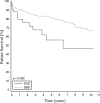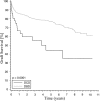Donation after cardiac death: the University of Wisconsin experience with liver transplantation
- PMID: 16244547
- PMCID: PMC1409855
- DOI: 10.1097/01.sla.0000186178.07110.92
Donation after cardiac death: the University of Wisconsin experience with liver transplantation
Abstract
Objective: To determine whether the outcomes of liver transplantation (LTx) from donation after cardiac death (DCD) donors are equivalent to those from donation after brain death (DBD) donors.
Summary background data: Because of the significant donor organ shortage, more transplant centers are using livers recovered from DCD donors. However, long-term, single-center outcomes of liver transplantation from DCD donors are limited.
Methods: From January 1, 1993, to July 31, 2002, 553 liver transplants were performed from DBD donors and 36 were performed from DCD donors. Differences in event rates between the groups were compared with Kaplan-Meier estimates and the log-rank test. Differences in proportion and differences of means between the groups were compared with Fisher exact test and the Wilcoxon rank sum test, respectively.
Results: Mean warm ischemic time at recovery in the DCD group was 17.8 +/- 10.6 minutes. The overall rate of biliary strictures was greater in the DCD group at 1 year (33% versus 10%) and 3 years (37% versus 12%; P = 0.0001). The incidence of hepatic artery thrombosis, portal vein stenosis/thrombosis, ischemic-type biliary stricture (ITBS), and primary nonfunction were similar between groups. However, the incidence of both hepatic artery stenosis (16.6% versus 5.4%; P = 0.001) and hepatic abscess and biloma formation (16.7% versus 8.3%; P = 0.04) were greater in the DCD group. Trends toward worse patient and graft survival and increased incidence of ITBS were seen in DCD donors greater than 40 years compared with DCD donors less than 40 years. Overall patient survival at 1 year (DCD, 80%; versus DBD, 91%) and 3 years (DCD, 68%; versus DBD, 84%) was significantly less in the DCD group (P = 0.002). Similarly, graft survival at 1 year (DCD, 67%; versus DBD, 86%) and 3 years (DCD, 56%; versus DBD, 80%) were significantly less in the DCD group (P = 0.0001).
Conclusions: Despite similar rates of primary nonfunction, LTx after controlled DCD resulted in worse patient and graft survival compared with LTx after DBD and increased incidence of biliary complications and hepatic artery stenosis. However, overall results of LTx after controlled DCD are encouraging; and with careful donor and recipient selection, LTx after DCD may successfully increase the donor liver pool.
Figures



References
-
- Busuttil RW, Tanaka K. The utility of marginal donors in liver transplantation. Liver Transpl. 2003;9:651–663. - PubMed
-
- Tisone G, Manzia TM, Zazza S, et al. Marginal donors in liver transplantation. Transplant Proc. 2004;36:525–526. - PubMed
-
- Department of Health and Human Services, Health Resources and Services Administration, Healthcare Systems Bureau, Division of Transplantation, Rockville, MD; United Network for Organ Sharing, Richmond VA; University Renal Research and Education Association, Ann Arbor, MI. 2004 Annual Report of the U.S. Organ Procurement and Transplantation Network and the Scientific Registry of Transplant Recipients: Transplant Data 1994–2003. www.optn.org/AR2004.
Publication types
MeSH terms
LinkOut - more resources
Full Text Sources
Medical

